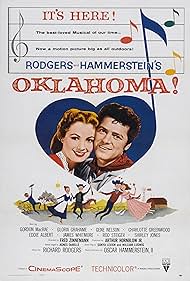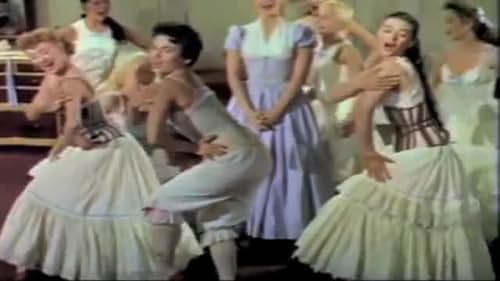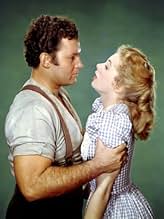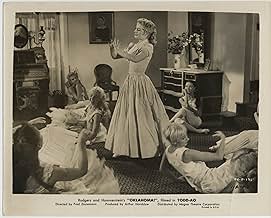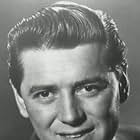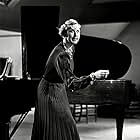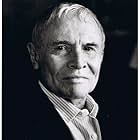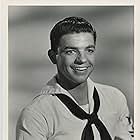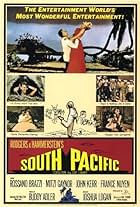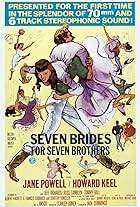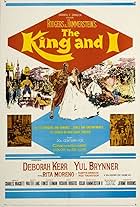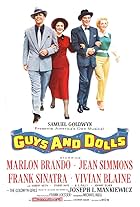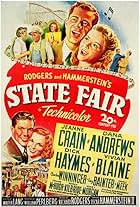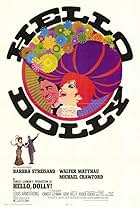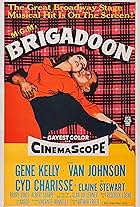In Oklahoma, several farmers, cowboys and a traveling salesman compete for the romantic favors of various local ladies.In Oklahoma, several farmers, cowboys and a traveling salesman compete for the romantic favors of various local ladies.In Oklahoma, several farmers, cowboys and a traveling salesman compete for the romantic favors of various local ladies.
- Won 2 Oscars
- 4 wins & 4 nominations total
Storyline
Did you know
- TriviaTone-deaf Gloria Grahame sang without dubbing. Her songs had to be edited together from recordings made almost literally note by note.
- GoofsWhen the words "The End" appear a square section of the sky/clouds directly behind "The" suddenly moves upward. However, It is fixed in the Blu-ray release.
- Alternate versionsTheatrical versions -- The Todd-AO 70mm version and the CinemaScope 35mm version are completely different, with different opening credits, each scene being shot twice and with different sound mixes. In the Todd-AO version, the titles appear against a black background; then, the black background fades out to reveal two rows of giant cornstalks, through which the camera tracks, until it finds Gordon MacRae singing "Oh, What a Beautiful Mornin". In the CinemaScope version, we first see the cornstalks, the camera tracks through them; then, as the words "Rodgers and Hammerstein present" appear on-screen, Gordon MacRae appears and rides up to the camera and then past it off left, as the title "Oklahoma!" appears. The rest of the opening credits in this version are shown against, first, a background of a barn, then, a meadow with a tree nearby. As the credits end, the camera cuts back to MacRae and he begins singing. At the end of the Todd-AO version, we see the words "A Magna Release". At the end of the CinemaScope version, we see the words "A Magna Production - Distributed by RKO Radio Pictures".
- ConnectionsFeatured in All You Need Is Love: Introduction (1977)
- SoundtracksOverture
(uncredited)
Music by Richard Rodgers
Lyrics by Oscar Hammerstein II
Performed by the 20th Century-Fox Studio Orchestra
Conducted by Jay Blackton
[Played over opening title card]
Featured review
Back in 1957 I saw this film when it was re-released and playing as a double feature with Carousel. Talk about musical entertainment, you can't do much better than that.
With a few numbers cut, this film version of the legendary Broadway musical is a faithful adaption of the show that premiered in 1943 and set a record of 2212 performances in a five year Broadway run at the St. James Theater. Oklahoma set a host of firsts on Broadway, the first musical to have an original cast album, the first also in the partnership of Richard Rodgers and Oscar Hammerstein, II.
Oklahoma on stage was also daring in that it had an extensive use of ballet, something unheard of for Broadway. Well, not quite because Richard Rodgers when he was writing with Lorenz Hart had Georges Balanchine do the famous Slaughter on Tenth Avenue ballet for On Your Toes.
But that was not as long as the dream ballet of Laurie that Agnes DeMille choreographed for Oklahoma. Agnes had previously choreographed Aaron Copland's composition Rodeo for a ballet and was a perfect choice for the musical with the western setting.
Would you believe that Oklahoma's origins came from a flop play by Lynn Riggs called Green Grow the Lilacs? The first person to play Curly was not Alfred Drake on stage or Gordon MacRae on film, but Franchot Tone. It's the closest the urbane Mr. Tone ever got to a western in his career. June Walker played the Laurie part in Green Grow the Lilacs that Joan Roberts did on stage and Shirley Jones did in this film. Green Grow the Lilacs ran a total of 64 performances back in 1931. But Dick Rodgers saw the musical possibilities in it.
MacRae was a proved commodity, but this was Shirley Jones's big screen debut. She followed it up with Carousel again co-starring with MacRae, just as the era of big screen musicals were ending. To some of us she's better known for singing those Rodgers&Hammerstein songs than for being the mother of the Partridge Family.
The secondary characters in the show are nicely cast with the secondary romantic triangle of Gene Nelson, Gloria Grahame, and Eddie Albert. One of the songs cut is a number called, It's a Scandal, It's an Outrage that Albert's character, peddler Ali Hakim sings. Albert did sing on stage and screen occasionally, I wish his number had stayed in. All he got out of the film as we well know is a three day bellyache.
The songs of Oklahoma are part of our national musical treasure from the opening of Oh, What a Beautiful Morning to the rousing title song almost at the very end. On stage, Oh, What a Beautiful Morning is sung off stage with a farm house setting and the Aunt Eller character, Charlotte Greenwood, sitting and churning butter. On stage MacRae is on horseback, riding through a cornfield where you can really see the corn is as high as an elephant's eye.
Rodgers&Hammerstein also gave one state in the union probably the best state song ever written at least in my humble opinion. The infectious and optimistic Oklahoma is in fact now the state song of the Sooner state. You can't sit quietly and listen and watch that number when its on, I defy anyone to.
Another big hit is People Will Say We're in Love that MacRae and Jones sing trying terribly hard to convince each other they're not crushing out. A favorite of mine has always been the ballad that Jones sings, Many A New Day to cheer herself up when MacRae hasn't asked her to the dance.
The plot of Oklahoma is slight, a couple of wholesome young people playing courting games about a dance. The problem is that the brooding hired hand of Jones and Greenwood's farm is used to make MacRae jealous. That would be Jud Fry, played with appropriate menace by Rod Steiger. The method acting Mr. Steiger stands out in this cast, but he's supposed to, because he's not really part of the community of farmers and cowmen. Among all these musical performers, Mr. Steiger proves to actually have a few nice notes in his voice as he joins MacRae singing Poor Jud is dead.
It took over ten years for Oklahoma to finally make it to the big screen. It took home Oscars for sound and musical scoring. It was well worth the wait.
With a few numbers cut, this film version of the legendary Broadway musical is a faithful adaption of the show that premiered in 1943 and set a record of 2212 performances in a five year Broadway run at the St. James Theater. Oklahoma set a host of firsts on Broadway, the first musical to have an original cast album, the first also in the partnership of Richard Rodgers and Oscar Hammerstein, II.
Oklahoma on stage was also daring in that it had an extensive use of ballet, something unheard of for Broadway. Well, not quite because Richard Rodgers when he was writing with Lorenz Hart had Georges Balanchine do the famous Slaughter on Tenth Avenue ballet for On Your Toes.
But that was not as long as the dream ballet of Laurie that Agnes DeMille choreographed for Oklahoma. Agnes had previously choreographed Aaron Copland's composition Rodeo for a ballet and was a perfect choice for the musical with the western setting.
Would you believe that Oklahoma's origins came from a flop play by Lynn Riggs called Green Grow the Lilacs? The first person to play Curly was not Alfred Drake on stage or Gordon MacRae on film, but Franchot Tone. It's the closest the urbane Mr. Tone ever got to a western in his career. June Walker played the Laurie part in Green Grow the Lilacs that Joan Roberts did on stage and Shirley Jones did in this film. Green Grow the Lilacs ran a total of 64 performances back in 1931. But Dick Rodgers saw the musical possibilities in it.
MacRae was a proved commodity, but this was Shirley Jones's big screen debut. She followed it up with Carousel again co-starring with MacRae, just as the era of big screen musicals were ending. To some of us she's better known for singing those Rodgers&Hammerstein songs than for being the mother of the Partridge Family.
The secondary characters in the show are nicely cast with the secondary romantic triangle of Gene Nelson, Gloria Grahame, and Eddie Albert. One of the songs cut is a number called, It's a Scandal, It's an Outrage that Albert's character, peddler Ali Hakim sings. Albert did sing on stage and screen occasionally, I wish his number had stayed in. All he got out of the film as we well know is a three day bellyache.
The songs of Oklahoma are part of our national musical treasure from the opening of Oh, What a Beautiful Morning to the rousing title song almost at the very end. On stage, Oh, What a Beautiful Morning is sung off stage with a farm house setting and the Aunt Eller character, Charlotte Greenwood, sitting and churning butter. On stage MacRae is on horseback, riding through a cornfield where you can really see the corn is as high as an elephant's eye.
Rodgers&Hammerstein also gave one state in the union probably the best state song ever written at least in my humble opinion. The infectious and optimistic Oklahoma is in fact now the state song of the Sooner state. You can't sit quietly and listen and watch that number when its on, I defy anyone to.
Another big hit is People Will Say We're in Love that MacRae and Jones sing trying terribly hard to convince each other they're not crushing out. A favorite of mine has always been the ballad that Jones sings, Many A New Day to cheer herself up when MacRae hasn't asked her to the dance.
The plot of Oklahoma is slight, a couple of wholesome young people playing courting games about a dance. The problem is that the brooding hired hand of Jones and Greenwood's farm is used to make MacRae jealous. That would be Jud Fry, played with appropriate menace by Rod Steiger. The method acting Mr. Steiger stands out in this cast, but he's supposed to, because he's not really part of the community of farmers and cowmen. Among all these musical performers, Mr. Steiger proves to actually have a few nice notes in his voice as he joins MacRae singing Poor Jud is dead.
It took over ten years for Oklahoma to finally make it to the big screen. It took home Oscars for sound and musical scoring. It was well worth the wait.
- bkoganbing
- May 4, 2007
- Permalink
- How long is Oklahoma!?Powered by Alexa
Details
- Release date
- Country of origin
- Language
- Also known as
- Oklahoma
- Filming locations
- Elgin, Arizona, USA(train station musical number scene)
- Production companies
- See more company credits at IMDbPro
Box office
- Budget
- $5,000,000 (estimated)
- Gross worldwide
- $16,133
- Runtime2 hours 25 minutes
- Color
Contribute to this page
Suggest an edit or add missing content

